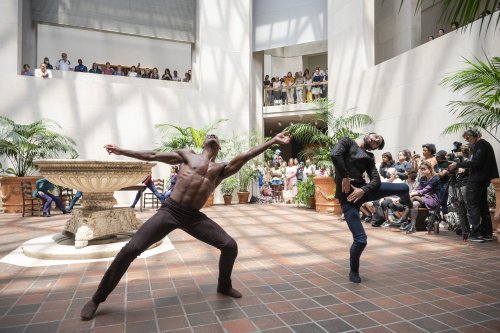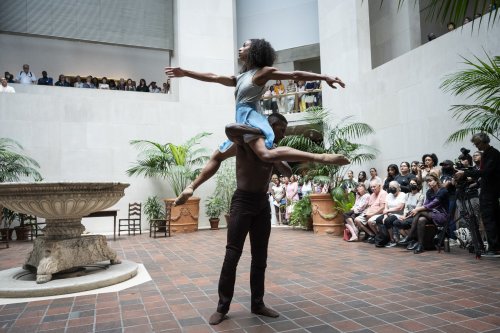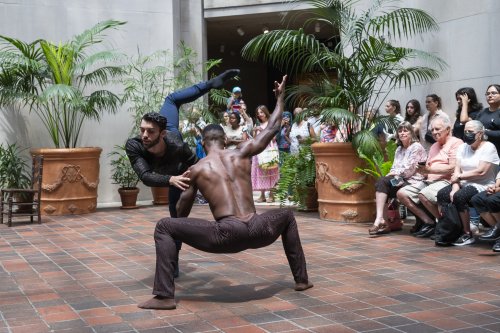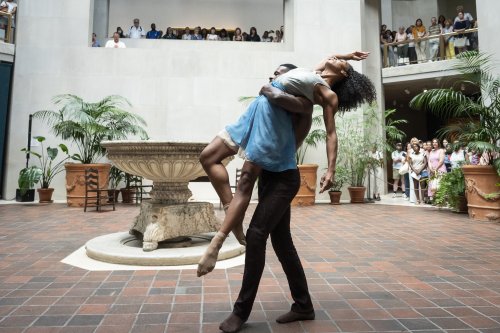Ballet Hispánico: Buscando a Juan
A new ballet honors Juan de Pareja, a seventeenth century Afro-Hispanic painter.

Leonard Brito and Antonio Cangiano of Ballet Hispánico in a scene from Eduardo Villaro’s “Buscando a Juan” at The Robert Lehman Wing of The Metropolitan Museum of Art (Photo credit: Paula Lobo)
[avatar user=”Joel Benjamin” size=”96″ align=”left”] Joel Benjamin, Critic[/avatar]
Ballet Hispánico, fresh from an exciting mini-season at New York City Center, presented the world premiere of a site-specific ballet by Eduardo Vilaro, Buscando a Juan (Looking for Juan), at the beautiful Robert Lehman Wing of The Metropolitan Museum of Art, in conjunction with the current exhibit “Juan de Pareja: Afro Hispanic Painter.” Vilaro is the artistic director and CEO of Ballet Hispánico (BH) and a former member of the troupe.
The Juan of the title is Juan de Pareja, the 17th century Afro-Hispanic painter whose intriguingly sensual portrait, painted by Diego Velázquez, hangs not far from the where the BH dancers poured out their emotions. Sadly, Pareja was enslaved by Velázquez, but was freed and had a successful career as a painter until his death in 1670.

Gabriela Sprauve and Leonardo Brito of Ballet Hispánico in a scene from Eduardo Villaro’s “Buscando a Juan” at The Robert Lehman Wing of The Metropolitan Museum of Art (Photo credit: Paula Lobo)
Set in the Court Level, around a large, ornate stone fountain, Buscando, commissioned by MetLiveArts, fit nicely in this evocative space, surrounded on high by a circular gallery from which the large audience of museum-goers took in the choreography. Vilaro set his dance to Osvaldo Golijov’s La Pasión segun San Marcos, a score that had a constant rhythm—sometimes low key, sometimes pulsating—that supported both the slow and swift sections of the ballet.
The commanding Leonardo Brito as the spirit of Pareja entered wearing a costume that was a cross between armor and a tapestry, later torn off him by the rest of the less colorfully dressed dancers: Fatima Andere, Antonio Cangiano, Amanda del Valle, Dylan Dias McIntyre, Omar Rivéra and Gabriella Sprauve (who distinguished herself at City Center in her portrayal of Sor Juana in a new ballet). No costume designer was credited.

Antonio Cangiano and Leonardo Brito of Ballet Hispánico in a scene from Eduardo Villaro’s “Buscando a Juan” at The Robert Lehman Wing of The Metropolitan Museum of Art (Photo credit: Paula Lobo)
Brito’s slow, stately entrance culminated with him sitting like a calm statue on a wooden table that became a throne.
The ensemble entered, standing in a corner, shape-shifting into various tableaus, their arms reaching, torsos bending and legs rising and falling. Soon they spaced themselves around the fountain repeating their slow movements until their journey culminated in that costume tearing. They exited.
Sprauve returned, now in a skirt and blouse and seemed to be a muse to Brito’s Pareja. The two proceeded into a long sensual—not sexual—duet. They walked and wrapped themselves about each other. He lifted her onto his shoulder and spun her, her long legs tracing the air. Again, the table was the destination.

Leonardo Brito and Gabriela Sprauve of Ballet Hispánico in a scene from Eduardo Villaro’s “Buscando a Juan” at The Robert Lehman Wing of The Metropolitan Museum of Art (Photo credit: Paula Lobo)
The work ended with the ensemble surrounding the leads.
There is an elegiac formality to Buscando. However, other than Juan de Pareja’s name in the title there is little in the choreography that evokes either period or personality. The choreography is interesting, yes, but were it not for informative program notes available online, Brito might have been a Christ figure with a dusting of Latin finesse and pulse and Sprauve a Mary Magdalene substitute.
The dancing was beautiful throughout.
Ballet Hispánico: Buscando a Juan (July 13-15, 2023)
MetLiveArts commission
The Robert Lehman Wing, Court Level, of The Metropolitan Museum of Art, 1000 Fifth Avenue, in Manhattan
For tickets, call 212-535-7710 or visit http://www.metmuseum.org
Running time: 20 minute without an intermission






Leave a comment